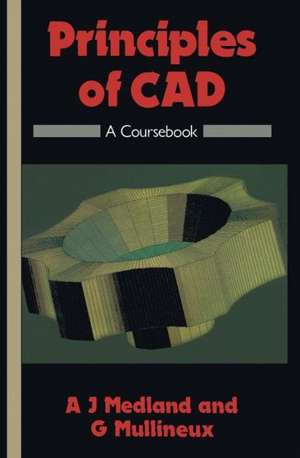Principles of CAD: A Coursebook
Autor A. J. Medlanden Limba Engleză Paperback – 30 iun 1988
Preț: 381.00 lei
Nou
Puncte Express: 572
Preț estimativ în valută:
72.91€ • 75.66$ • 60.94£
72.91€ • 75.66$ • 60.94£
Carte tipărită la comandă
Livrare economică 15-29 martie
Preluare comenzi: 021 569.72.76
Specificații
ISBN-13: 9781850915348
ISBN-10: 1850915342
Pagini: 236
Ilustrații: XVIII, 218 p.
Dimensiuni: 133 x 203 x 12 mm
Greutate: 0.25 kg
Ediția:Softcover reprint of the original 1st ed. 1988
Editura: Springer Us
Colecția Springer
Locul publicării:New York, NY, United States
ISBN-10: 1850915342
Pagini: 236
Ilustrații: XVIII, 218 p.
Dimensiuni: 133 x 203 x 12 mm
Greutate: 0.25 kg
Ediția:Softcover reprint of the original 1st ed. 1988
Editura: Springer Us
Colecția Springer
Locul publicării:New York, NY, United States
Public țintă
ResearchCuprins
Section 1 The Design Process.- Module 1.1 The Relationship between Geometry and Function.- Module 1.2 The Form of the Design Process.- Module 1.3 Traditional Drawing Practices.- Module 1.4 The Development of the CAD Industry.- Exercises.- Section 2 System Configuration.- Module 2.1 Workstations.- Module 2.2 Computers—Mainframes to Micros.- Module 2.3 Output Devices.- Module 2.4 Data Storage.- Module 2.5 Networked Systems.- Exercises.- Section 3 Entity Descriptions.- Module 3.1 Points, Lines and Circular Arcs.- Module 3.2 Basic Geometric Manipulations.- Module 3.3 Free-form Curves 1.- Module 3.4 Free-form Curves 2.- Module 3.5 Finding Intersections of Free-form Curves.- Module 3.6 Surfaces.- Exercises.- Section 4 View Transformations.- Module 4.1 Two-dimensional Transformations—Pan, Rotate and Zoom.- Module 4.2 Three-dimensional Transformation Matrices.- Module 4.3 Axial and Observer Systems.- Module 4.4 The Use of Perspective.- Module 4.5 Multi-view Presentations.- Module 4.6 Advanced Viewing Techniques.- Exercises.- Section 5 Types of CAD Modelling Systems.- Module 5.1 Two-dimensional Drafting Practice.- Module 5.2 Three-dimensional Wireframe Models.- Module 5.3 Surface Modelling.- Module 5.4 Solid Modelling.- Module 5.5 Display of Solid Models.- Exercises.- Section 6 The User Interface.- Module 6.1 User Command Language.- Module 6.2 Use of Menus.- Module 6.3 Graphics Interface Languages.- Module 6.4 Use of Parametrics.- Exercises.- Section 7 System Effectiveness and Organization.- Module 7.1 Information Flow.- Module 7.2 Establishing Design Needs.- Module 7.3 Identifying Benefits.- Module 7.4 Training for Operation.- Module 7.5 Working Environment.- Module 7.6 Design and Social Structure.- Module 7.7 System Management.- Exercises.- Section 8 ApplicationsPrograms.- Module 8.1 Analysis-centred Applications Programs.- Module 8.2 Manufacturing-centred Applications Programs.- Module 8.3 Control-centred Applications Programs.- Further Reading.







